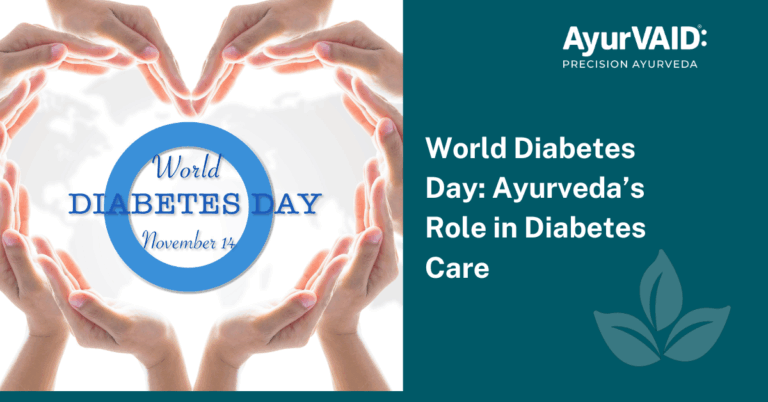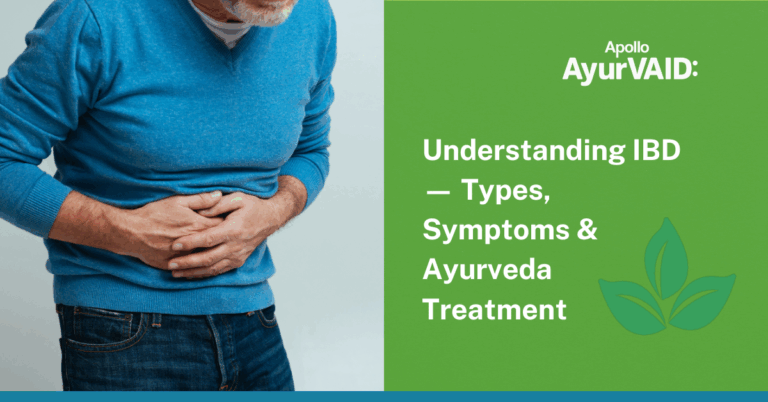Introduction
Winter can significantly aggravate knee pain, making daily activities challenging and uncomfortable for many individuals. Sprained or strained ligaments, cartilage tears, tendonitis, and arthritis can all lead to knee joint pain. The most common systemic causes of knee pain among these are osteoarthritis and rheumatoid arthritis. As per Ayurveda, Vata dosha gets aggravated in winter (which governs movement) leading to exacerbated joint stiffness and pain. Understanding this interplay between cold weather and joint health is crucial, as it helps explain why many people experience increased discomfort during winter months. Ayurveda remedies for knee pain due to cold weather aim at balancing Vata dosha, thus addressing root causes along with symptoms.
In this blog, let’s explore some key treatment modalities in Ayurveda for knee pain, lifestyle modifications, dietary changes, and home remedies that are beneficial in alleviating pain and improving joint health.

Understanding Knee Pain in Winter
Knee pain is known as Janu Sandhi Shoola in Ayurveda, where Janu means the knee, Sandhi means the joint, and Shoola implies pain. Winter is cold and dry thus it can aggravate Vata and Kapha dosha, causing Joint stiffness, reduced flexibility, increased pain, discomfort, reduced circulation in the knee area, and muscle tension around the joint. This is a common symptom in Sandhigata Vata (osteoarthritis) and Ama Vata (rheumatoid arthritis). Diagnosing the correct underlying cause of knee pain, assessing the dosha predominance, and planning the treatment accordingly help tackle the condition from the root and prevent further deterioration.
Ayurveda Treatment Approaches
Knee pain treatment in Ayurveda includes panchakarma therapy, internal medication, and changes in lifestyle and food habits. The modality is chosen depending on the intensity of the pain, and the patient’s condition. In the case of knee pain due to OA, the focus is on the nourishment of the joints, reduction of Vata, and improvement of the lubrication. In contrast, the focus for rheumatoid arthritis (RA) is on improving digestion, eliminating toxins (Ama), and lowering inflammation. For further reading on the difference between OA and RA please visit https://ayurvaid.com/blog/understanding-the-difference-between-osteoarthritis-oa-and-rheumatoid-arthritis-ra/
Apollo AyurVAID has a standard operating procedure for knee pain management that includes Ayurveda medication, specific therapies, and functional rehabilitation with diet and lifestyle modifications. The scope of this approach involves health assessment, differential diagnosis, and Ayurveda intervention plans. The treatment aims to decrease inflammation, halt the progression of the disease, nourish the degenerated tissues, and avoid further complications and disease episodes.
Panchakarma Therapies
Certain Panchakarma therapies are required to address the imbalance in doshas and manage knee pain at the root cause level. They are –
- Abhyanga (oil therapy) with warm medicated oils can alleviate knee pain arising in OA, sprain, and strain of muscles. This can also reduce the dryness of the skin during winter.
- Local or whole-body Swedana (sudation) promotes sweating, alleviating stiffness and joint pain. This can be achieved with the help of different modalities such as Patra Pinda Sweda, Churna Pinda Sweda, Njavara/ Shastika Shali Pinda Sweda, etc.
- Dhara (streaming warm herbal decoction or oil) over the knee joint alleviates stiffness and pain.
- Lepa (medicated paste application) over the knee can alleviate inflammatory signs such as swelling, and redness.
- Pichu (applying an oil-soaked cotton pad) over the knee strengthens the joint.
- Virechana (therapeutic purgation) eliminates toxins, and balances vitiated doshas. This modality is especially beneficial if the knee pain is associated with swelling, redness, and other signs of inflammation.
- Vasti (enema) can be administered as a nourishing therapy for the joint and surrounding tissues—special types like Vaitarana Vastiare are effective in knee pain caused by rheumatoid arthritis.
- Janu Vasti – warm-medicated oil retention around the knee joint is beneficial. It can aggravate the pain if it is due to RA. Thus, ruling out RA is very essential.
Home Remedies for Knee Pain
Home remedies can improve knee joint health and prevent bone degeneration and pain in individuals with strong immune systems.
- Warm medicated oil application reduces pain and stiffness in knee joints caused by winter.
- Pain is relieved by hot fomentation with a rock salt poultice.
- Drinking enough water helps keep joints lubricated.
- The condition is addressed from the root cause by consuming anti-inflammatory and Vata-alleviating foods like cumin, turmeric, ginger, pepper, garlic, asafoetida, warm milk, and ajwain seeds.
- Healthy fats like ghee and gingelly oil strengthen and lubricate the knee joint.
- It is recommended to avoid raw vegetables and beans that provoke Vata.
- Pranayama can help reduce stress, ensure rest, and maintain a healthy body weight if you have a consistent daily routine. It in turn relieves pressure on the knee joint and prevents pain.

Dietary Recommendations
According to Ayurveda, one is supposed to take the Vata and Kapha balancing diet when suffering from knee joint pain. Some of the important tips are:
- One should avoid cold foods to balance digestive fire, Vata, and Kapha dosha.
- Do not consume foods prepared from newly harvested grains and foods that have undergone fermentation.
- Avoid dry or processed meats.
- Avoid taking foods that are salty and spicy.
- Warm and light foods such as vegetable soups and khichdi are beneficial.
- Include spices like turmeric, ginger, cumin, pepper, and garlic in your foods.
- Do not consume potatoes, curd at night, dry food, jamun, or beans.
Lifestyle Modifications
Proper diet and lifestyle modifications can greatly improve joint health, and mitigate pain. Following are a few lifestyle changes to be practiced to reduce knee pain and keep yourself healthy this winter.
Don’t sit for long periods, keep the joints warm, and stay active to maintain mobility and comfort. Gentle yoga poses including Warrior Pose (Virabhadrasana), Bridge Pose (Setu Bandhasana), and Half Forward Bend (Ardha Uttanasana) are recommended, which increase flexibility and strength. Moderate knee rotations, controlled knee bends, and walking can also benefit joint mobility.
Preventive Measures
- Proper covering of the knees also assists in preventing cold-related aches on the joints of the knees.
- Use kneecaps, and protective gear while walking or exercising.
- The stiffness and soreness of the joints are also relieved when the room is warm.
- Try to avoid cold areas as much as possible.
Conclusion
Knee joint pain in the winter can be managed with Ayurveda methods such as panchakarma, focused exercise, lifestyle adjustments, and nutritional measures. Regular sleep, meditation, deep breathing, weight management, and avoiding cold settings are all necessary for long-term recovery. Our therapeutic approach focuses on balancing the Vata dosha, enhancing circulation, reducing inflammation, and improving joint health. This approach to root cause management promotes effective pain control and improves overall quality of life.
References
- B, P (2019). Evidence Based Ayurvedic Treatment Guideline for Management of Sandhivata (Osteo-arthritis) Journal of Natural & Ayurvedic Medicine. https://doi.org/10.23880/jonam-16000211
- Arya, R et al. (2023). A Systematic Review on Panchakarma-Based Ayurveda Treatment in Janu Sandhigata Vata. International Journal of Ayurvedic Medicine. https://doi.org/10.47552/ijam.v14i1.3282
- Gupta, H et al. (2024). Recommended Lifestyle Modification for Elderly Patients with Knee Osteoarthritis. International Journal of Health Sciences and Research. https://doi.org/10.52403/ijhsr.20240735
- Chopra, A et al. (2010). Ayurveda–modern medicine interface: A critical appraisal of studies of Ayurvedic medicines to treat osteoarthritis and rheumatoid arthritis. Journal of Ayurveda and Integrative Medicine, 1, 190 – 198. https://doi.org/10.4103/0975-9476.72620
- Patel, D, Villalobos, A (2017). Evaluation and management of knee pain in young athletes: overuse injuries of the knee. Translational pediatrics, 6(3), 190-198. https://doi.org/10.21037/tp.2017.04.05






